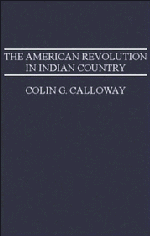Book contents
- Frontmatter
- Dedication
- Contents
- List of figures and maps
- Preface
- Acknowledgments
- Abbreviations
- Prologue New worlds for all: Indian America by 1775
- 1 Corn wars and civil wars: the American Revolution comes to Indian country
- 2 Odanak: Abenaki ambiguity in the North
- 3 Stockbridge: the New England patriots
- 4 Oquaga: dissension and destruction on the Susquehanna
- 5 Fort Niagara: the politics of hunger in a refugee community
- 6 Maquachake: the perils of neutrality in the Ohio country
- 7 Chota: Cherokee beloved town in a world at war
- 8 Tchoukafala: the continuing Chickasaw struggle for independence
- 9 Cuscowilla: Seminole loyalism and Seminole genesis
- 10 The peace that brought no peace
- Epilogue A world without Indians?
- Index
4 - Oquaga: dissension and destruction on the Susquehanna
Published online by Cambridge University Press: 18 December 2014
- Frontmatter
- Dedication
- Contents
- List of figures and maps
- Preface
- Acknowledgments
- Abbreviations
- Prologue New worlds for all: Indian America by 1775
- 1 Corn wars and civil wars: the American Revolution comes to Indian country
- 2 Odanak: Abenaki ambiguity in the North
- 3 Stockbridge: the New England patriots
- 4 Oquaga: dissension and destruction on the Susquehanna
- 5 Fort Niagara: the politics of hunger in a refugee community
- 6 Maquachake: the perils of neutrality in the Ohio country
- 7 Chota: Cherokee beloved town in a world at war
- 8 Tchoukafala: the continuing Chickasaw struggle for independence
- 9 Cuscowilla: Seminole loyalism and Seminole genesis
- 10 The peace that brought no peace
- Epilogue A world without Indians?
- Index
Summary
The American Revolution had perhaps no more direct and devastating impact than in Iroquois country. The conflict shattered the ancient unity of the Iroquois League and pitted brother against brother. Vicious border warfare disrupted normal patterns of Iroquois life, and American invasions crashed into Iroquoia, burning crops and villages, and sending refugees fleeing to the British for shelter. Ably recounted by Barbara Graymont in The Iroquois in the American Revolution, the Six Nations' experience in the Revolution was one of almost total disaster.
Historians have usually approached the story by looking at tribes rather than towns: of the six nations composing the Iroquois League, the Mohawks, Cayugas, Senecas, and most of the Onondagas sided with the British, whereas the Oneidas and most of the Tuscaroras espoused the American cause, and therein lay the tragedy. However, by focusing attention on a particular community, we get a fuller sense of the divisions that the Revolution wrought in Iroquois society and a deeper appreciation of its impact on individual lives. The story of Oquaga or Onoquaga, a melting pot for the Six Nations, mirrors the turmoil and suffering of Iroquoia in the Revolution, reminds us that in a civil war the lines of allegiance are not neatly drawn, and demonstrates that conflicts over church and state in the revolutionary era were not confined to white America. George III is reputed to have said that the Revolution was nothing more than “a Presbyterian rebellion.” If so, it was a rebellion with disastrous repercussions at Oquaga.
Located on the banks of the upper Susquehanna near present-day Windsor in Broome County, New York, in what was formerly Susquehannock hunting territory, Oquaga was one of the most important Indian communities in the area, and one of four main Oneida villages on the eve of the Revolution. It was a frontier crossroads sitting astride major Indian trails, and a rendezvous for the Susquehanna and Delaware rivers, where Indians from the south and west met traders from Albany and Schenectady.
- Type
- Chapter
- Information
- The American Revolution in Indian CountryCrisis and Diversity in Native American Communities, pp. 108 - 128Publisher: Cambridge University PressPrint publication year: 1995



